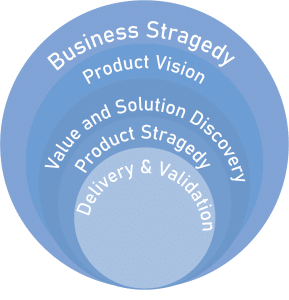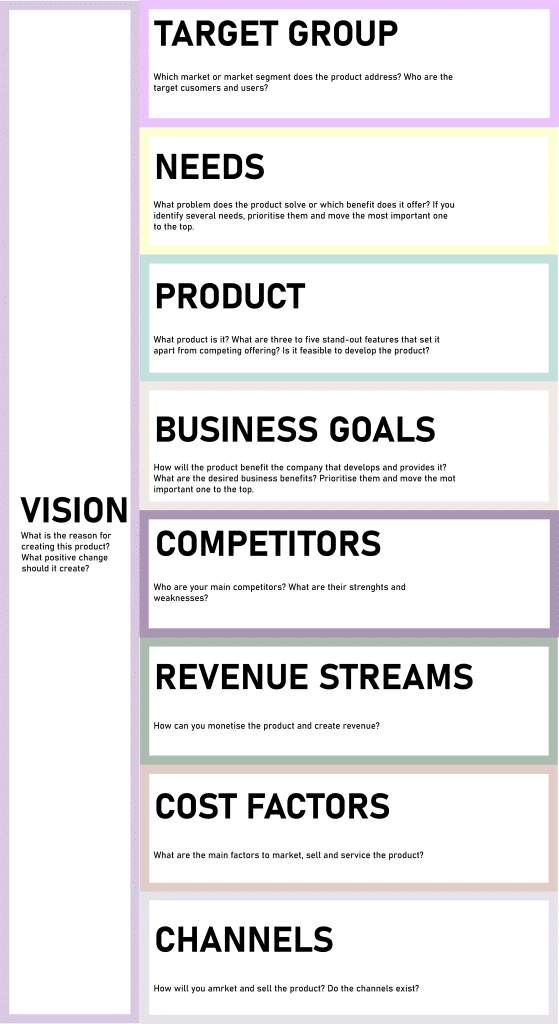Managing Products with Agility results in products that provide valuable business outcomes, increased flexibility to respond to change, and greater transparency for investment decisions in product development. A clear and understandable Product Vision helps to align product development with the organisation’s Business Strategy including strategic goals and/or business vision, while a focus on Product Value addresses the continuous improvements to the product. Product Value includes considerations such as greater transparency in value-based decisions and organization-wide, value-driven approaches. Key tenets of this Focus Area include continuously defining value, measuring actual value realized, validating assumptions, and analysing trends.
The process of aligning Product Vision with Product Value is iterative and incremental, and it is managed through continuous refinement of the Product Backlog. Effective Product Backlog Management requires input and collaboration from a variety of Stakeholders and Customers – including the Scrum Team – and requires evolving techniques to ensure appropriate levels of transparency based on the needs of stakeholders. Similarly, Forecasting and Planning uses an iterative and incremental approach to manage complexity, change, and the realities of business obligations. Attention to these Focus Areas results in development and delivery of valuable product increments within 30 days or less.
Forecasting and Release Planning
Complex problems and the application of an empirical process requires a specific way of planning, estimating, and forecasting. Practitioners should be able to apply agile forecasting and release planning techniques, and understand the value of different approaches. They should understand which approaches work better in different situations. They should also understand how releases should be planned while dealing with complexity, dependencies, and value creation.
Product Vision

The Product Vision describes the purpose of a Product. A good Product Vision expresses the value the Product should deliver and to whom that value is delivered. It is effective when people connect with the vision emotionally and practically. When a Product Vision is both aspirational and actionable, it inspires creativity within the Scrum Team allowing them to collaboratively work with Stakeholders on how they might work toward the vision.
The Product Vision is owned by the Product Owner, but its development requires input from stakeholders and the Scrum Team(s). A good Product Vision is built incrementally allowing many opportunities for inspection and adaptation.
Vision: the best thing a Product Owner can do to truly take ownership and inspire others is to establish and communicate a clear vision for the Product. Why are we building it? Whose lives will be improved by it?
Value: the best thing a Product Owner can do to move away from a project mindset (time, budget, scope) to more of a product mindset (value to stakeholders) is to define and communicate what success looks like. Is it customer satisfaction? Operating costs? Registrations? How will we measure it? How do we know when the value received no longer outweighs the costs?
Validation: the best way a Product Owner can actively manage risk is to shorten the feedback loop by validating frequently with internal experts and, even better, with the external marketplace. A professional Product Owner knows that the only way to move the needle on any value measurement is to release to customers. Until then, everything is just a hypothesis.
A professional Product Owner embraces empiricism as a way to address the complexity and risk of building something unknown. The three Vs fit perfectly with the three pillars of empiricism:
Vision creates Transparency.
Defining Value provides you with something to Inspect.
Validation causes Adaptation.
The Product Vision should be a free-standing, transparent instrument that enables stakeholders and the Scrum Team to understand the intention of a Product. However, even though it should stand on its own, a Product Vision exists in the context of two other critical elements: Business Strategy and Product Strategy.

Product Vision
Product Strategy and Product Vision.
The product strategy takes the vision and tells you how that will be executed. The strategy can include a Product Roadmap, which represents a view of the key product milestones that the product strategy describes. The product strategy will define the product’s persona(s), the problems the product will solve, and what success looks like. The Product Strategy defines the Product Goal, which is a commitment to the Product Backlog. The Product Goal provides guardrails for the Product Backlog enabling choices to be made about what should be in or out of the Product Backlog. The reality is that this understanding will change over time, requiring an iterative process. Each Sprint is an opportunity to review the Product Vision, Product Strategy and other elements of the business to ensure that they still make sense.
Characteristics of a Product Vision
The detail of a Product Vision will depend on the situation. For example, a Product Vision for a new corporate loan tool would differ significantly from one created for the next generation of online football games. Not only is the subject matter different, but the audience is as well. The Product Vision should be stated in a way that the Scrum Teams working on the product and the stakeholders involved in the work have a shared understanding of it. It should be written in the language of its audience.
A Product Vision should provide the glue that connects the work of the Developers with the
strategy of the business and organisation.
The most important aspect of a Product Vision is that it is simple and in a form that the audience can understand and relate to. That may mean having different representations of the Product Vision for different audiences. For example, one audience likes a presentation and another wants a simple statement. One audience is interested in the product’s audience, another is more focused on the high level features or needs. However, when there are multiple representations of a Product Vision, those items must be kept up-to-date and connected.
Communicating the Product Vision
| 10 Tips for Product vision: | |
|---|---|
| 1. Be(come) the owner of the Product vision | 6. Adapt your vision pitch, based upon your target audience |
| 2. Share your Product vision, often | 7. Focus on value for customers and users, not on technology |
| 3. Don’t believe your idea is the best idea ever | 8. Keep your vision short, clear, and inspiring |
| 4. Develop your vision iteratively and incrementally | 9. Make the vision fit in the company’s vision and stragedy |
| 5. Adapt your vision as you’re learning | 10. Validate your vision with stakeholders, the Scrum Team and market |
Key stakeholders and Customers
Effectively working with stakeholders and customers is a key skill for everyone on the Scrum Team. Scrum changes the nature of the interactions, encouraging more frequent collaboration and more open dialogue.
Anyone who is impacted by the outcome of the product and is interested in its success is considered a stakeholder.
Examples of a Scrum Team’s stakeholders may include:
- Customers – users and buyers of the product
- Internal stakeholders – company management and other organizations such as Human Resources/Talent Management, compliance, finance, etc.
- Partners – suppliers, vendors and other business partners.
- Influencers – external influencers such as trade organisations, media or industry analysts.
Engaging with stakeholders is central to the success of any kind of product development. Only they can provide the feedback necessary to ensure that the product satisfies their needs and expectations.
The Importance of Stakeholders in Scrum
- A core tenet of Scrum is that the Scrum Team receives rapid and frequent feedback from stakeholders in order to inspect and adapt its work. The entire Scrum Team is responsible for stakeholder collaboration; it is not just the Product Owner’s responsibility. Scrum provides many elements that support the Scrum Team’s collaboration with key stakeholders:
- Sprint Review – this Scrum event is a working meeting for the Scrum Team to ask for feedback and guidance from their stakeholders.
- Product Goal – this concrete, measurable objective helps the Scrum Team and stakeholders understand if they are making progress toward fulfilling the product vision.
- Product Backlog – this Scrum artifact provides a means for the the Scrum Team and stakeholders to drive to a common understanding of what must be done to achieve the Product Goal and deliver the product.
- Increment – the Scrum Team works to provide a product Increment for review by the stakeholders at the Sprint Review.
These elements are built into the framework to provide formal opportunities for stakeholder
interaction during the Sprint. However, these should not be considered the only opportunities to interact with stakeholders. Scrum Teams are encouraged to interact frequently with their stakeholders.
Key Stakeholders
While it’s important to understand who all of the Scrum Team’s stakeholders might be, not all stakeholders must be treated in the same way. Scrum Teams should engage with stakeholders in the ways appropriate for getting the feedback they need. For example, some of the stakeholders should regularly engage with the Scrum Team using Scrum artefact’s and Scrum events, but others may cause a distraction. All stakeholders are important, but only key stakeholders are invited to participate in Scrum events and artefacts.
Here are different ways Scrum Teams can try to understand who their key stakeholders are and how to engage with them:
- Engage in a Stakeholder Mapping activity to better understand who their stakeholders are.
- Create a Stakeholder Engagement Approach to engage the right people at the right time to maximise the value of the product.
- Learn and use techniques to better understand their customers and their customers’ needs.



